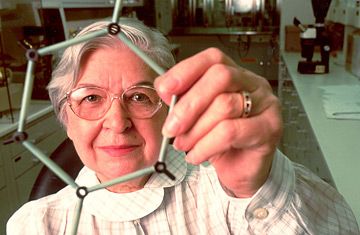WHEN STEPHANIE LOUISE KWOLEK RECEIVE D HER B.S., WITH a major in chemistry, from the Carnegie Institute of Technology (now Carnegie Mellon University) in 1946, she didn’t have enough money to pursue her dream of going on to medical school. So she accepted a research job with DuPont, hoping to eventually get a medical degree.
D HER B.S., WITH a major in chemistry, from the Carnegie Institute of Technology (now Carnegie Mellon University) in 1946, she didn’t have enough money to pursue her dream of going on to medical school. So she accepted a research job with DuPont, hoping to eventually get a medical degree.
Kevlar
YearAdded:
Image Credit:
Image Caption:
Era_date_from:
Just after World War II ended, Stephanie Louise Kwolek tucked her new chemistry degree from the Carnegie Institute of Technology under her arm and—because she couldn’t afford medical school—took a research job at DuPont’s textile fibers department in Buffalo. Although she faced many challenges as one of the few women in chemical research, she liked the work so much that she soon dropped her plans to become a doctor. Two decades later she would invent Kevlar, one of the world’s most versatile materials, and along with it a new branch of polymer chemistry.
YearAdded:
Image Credit:
Image Caption:
Era_date_from:
By:
Winter 2020 | Volume 26, Issue 1
WHEN STEPHANIE LOUISE KWOLEK RECEIVED HER B.S., WITH a major in chemistry, from the Carnegie Institute of Technology (now Carnegie Mellon University) in 1946, she didn’t have enough money to pursue her dream of going on to medical school. So she accepted a research job with DuPont, hoping to…
By:
Fall 2010 | Volume 25, Issue 3
Just after World War II ended, Stephanie Louise Kwolek tucked her new chemistry degree from the Carnegie Institute of Technology under her arm and—because she couldn’t afford medical school—took a research job at DuPont’s textile fibers department in Buffalo. Although she faced many challenges as…


